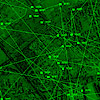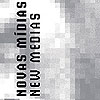 A
special
feature
from
Furtherfield.org.
A
special
feature
from
Furtherfield.org.You can find more reviews and information about the furtherfield team at furtherfield.org
---------------------
World (2003 - Glorious Ninth)
This strangely emotional work weaves finely tuned aesthetic formalism with polemic. Unusually for Internet based media works (though not for much of the generative Shockwave work made by collaborators Kate Southworth and Patrick Simons of GloriusNinth), after an initial cascade of data, the piece unfolds at an intensely slow pace, inducing a mesmeric state in the viewer and winding down the desire to click, for the next feature.
To the left of the screen, the word [R]evolution builds layer on layer, becoming bolder but more disrupted, threatening to blot itself out through reiteration. In the right hand column, smaller texts emerge and fade imperceptibly in falling, fields of high colour; visual interference like every bit of news information ever displayed on any screen through history; atomised, appropriated and reworked by a new mechanical order. The tenor of these texts is that of disrupted and upset internal dialogues sparked by bewildering, morally fractured world affairs. These act in combination with the full title of the work 'World#---saved 10.10.01' to suggest a reference to another historical date- 9/11/01. What was saved on this date? The work or the world?
Over time, the work unfolds quiet, crafted, layers to the riddle with a deliberate subtlety that suggests a kind of inspired fanaticism in its creators, a refusal to draw conclusions. The intangible (or non existent- I can't be sure) interactivity of this work challenges and proliferates notions of individual agency within social [r]evolution.
:: Ruth Catlow of Furtherfield
 Originally
published
on
11/26/03
Originally
published
on
11/26/03How creative artists can be with so little always amazes. Take, for example, small squares and a set of lines and combine them with simple scripts in a Flash interface; then add sounds of explosions and a grid-like background of an urban terrain. The result is an allegorical combination of the ideas of war and networks. This is what immediately comes to mind when experiencing Nuzita.net's online project W4R.
The user is instructed to click on the little squares during the introduction. That simple action, though, is more difficult than it seems; the dots are constantly shifting from one area of the screen to another in a seemingly random fashion. After playing with the dots for a bit, I started to think about the event as a form of abstract battle with no specific enemies or allies. My only aim was to be able to hover over a square and then click. I was finally able to do this and my reward was a pop-up window displaying a set of consecutive images -- details, actually, of the background graphics in the main interface.
After clicking on a few more dots, I thought about my pointless drive and the fact that I still wanted to do it. The images repeated every time another popup window appeared. I eventually stopped and simply looked at the dots and lines moving.
And I considered it an animated abstract painting with added sound. No. It was the idea of war abstracted to be digested as a type of object of reflection. No. It was the drive to interact with others reflected through signifiers of war as a non-productive form of communication. No. And then I realized that the best analogy is as a commentary on video games and the banal hype of skilled repetitive actions for the sake of a higher score to eventually beat the game; only here, there is no score; there are no sides; there are only the basic signifiers of violence in battles abstracted and carefully combined with specific ideas of the network through which W4R is also actually disseminated. Then I thought this was not it, either. In the meantime the dots kept moving.
Artist: Antonio Dominguez
:: Eduardo Navas ::
 Originally
published
on
11/25/03
Originally
published
on
11/25/03Brazilian new media festival FILE (Electronic Language International Festival) launched its 2003 edition book called "NOVAS MIDIAS/NEW MEDIAS." It contains, amongst others, writings by Ricardo Barreto, Paula Perissinotto, Artur Matuck and Ricardo Rosas. All in all, it could make an interesting piece of writing. But what is even more interesting is that somebody at the organization made an enormous effort to take jpg images of all pages of the book, resize them and make them ready for the net. The result is a seemingly endless series of HTML pages with images of pages that are unreadable because they're size is just too small, which makes it in my eyes an absurd piece of promotion that unintentionally could become a source of inspiration for net artists. Start your experience of this non event here:
http://www.file.org.br/file2003/english/
livro/file_livro_capa.htm
:: Peter Luining ::
 Originally
published
on
11/20/03
Originally
published
on
11/20/03Having access to information becomes vital for creating a history. As new technology is developed, more efficient ways of archiving are introduced in various fields of research. The main preoccupation by those developing new archiving technologies is the preservation of information for future generations. The computer database is perhaps the most popular and efficient form for archiving and accessing information today.
In Le Catalogue, the mastermind behind h-arn.org has created a database of documentary images (an archive) of art projects between 1990-1996 that's available for public access. Every time an image is viewed, a horizontal line and a vertical line forming a cross are added to the archived image, which is then again stored for access by another user. The more the images are accessed, the more they are abstracted or -- if one is thinking of preservation -- destroyed.
Here, the archive is similar to analog vinyl records losing their fidelity and being slightly deteriorated every time the needle passes through the groove. Unlike a record player, however, which is fabricated with the aim to provide the least damage possible while offering an aesthetic experience to the user, Le Catalogue actually makes the most of destruction in order to create a unique image for the present user. The image is unique in time and space because next time the same file is accessed, there will be two more lines added, and so on.
In this way, Le Catalogue takes on the idea of destruction as a progressive movement, bringing on the new; and so, one can look forward to destruction as a type of online collaboration, where the archived information is not preserved but rather reinterpreted as constantly shifting information. History is here dependent on linear traces that expose the instability of interpretation; much like tree rings, traces are left behind by the process of development, leaving us with an allegorical database presenting destruction as an inevitable part of life.
:: Eduardo Navas ::